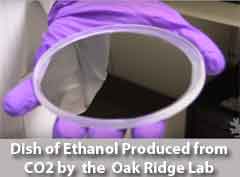| There was news last week that researchers at the Oak Ridge National Laboratory in Tennessee have discovered a chemical reaction to turn CO2 into ethanol. While still in its early phases, the discovery could be a breakthrough that would impact the approach to reducing CO2 emissions across the globe.
The process, as reported by Popular Mechanics magazine, involves passing CO2 across a combination of copper and carbon arranged into nanospikes - which basically just means material jutting up irregularly on a nana scale from a silicon surface, and charging the CO2 with electricity. The nanotechnology allows the reactions to be very precise, with very few contaminants.
The Oak Ridge researchers actually got different results than they expected. First, to turn CO2 into some other substance, they were expecting a series of chemical reactions would be required – it turned out just one reaction did the trick.
Second, the researchers were expecting the end result to be methane gas; instead the process produced liquid ethanol, which is more versatile as a fuel, for example used in part to power automobiles.
The process also uses common materials like copper and carbon, versus other attempts at similar CO2 conversions that required more exotic materials, and also operates at room temperature, which reduces energy costs and provides more operational flexibility in starting up and shutting down the process.
Of course, the process assumes there is a readily available source of CO2. Where would it come from? Neither the Popular Mechanics article nor a video related to the process from the Oak Ridge Lab web site addresses this issue.
However, The Green Supply Chain.com notes there is a known approach to capturing CO2 from major emitters such as power plants and some manufacturing sites. It goes by the name of “capture and sequestration,” and involves a complex process by which carbon is captured from the exhaust of those sources, and then the transport of that captured CO2, generally via pipelines.
The transport is to sites that can perform underground injection and geologic sequestration (storage) of the CO2 into deep underground rock formations. These formations are often a mile or more beneath the surface and consist of porous rock that holds the CO2. Overlying these formations are impermeable, non-porous layers of rock that trap the CO2 and prevent it from migrating upward.
This sequestration process is of course hugely expensive. If the captured CO2 could be transported to a factory that could use this new process to produce ethanol, it could change the whole economic dynamic of capturing carbon at the source of emissions.
The process is pretty efficient already, says Oak Ridge researcher Adam Rondinone, achieving a yield of about 65%, meaning that for every 100 electrons in the CO2 molecules, 65 of them will end up stored as ethanol. The rest go to something else, primarily hydrogen. Rondinone thinks that yield could go even higher over time.
 The energy efficiency of the process – meaning how much energy is produced versus how much is consumed – is positive but needs some improvement for the process to be commercially viable. However, Rondinone thinks that efficiency can also be improved, and notes that the process could be run at nights or weekends where in some areas electricity costs less. The energy efficiency of the process – meaning how much energy is produced versus how much is consumed – is positive but needs some improvement for the process to be commercially viable. However, Rondinone thinks that efficiency can also be improved, and notes that the process could be run at nights or weekends where in some areas electricity costs less.
Oak Ridge is also positioning the technology as a way to store energy from other renewable sources such as solar and wind. So, for example, when energy from those sources is high, part of the resulting electricity could be used to power this process, producing storable ethanol that could be used by power plants to produce electricity say when solar output is low.
Rondinone added that "If someone was interested in making chemical feedstocks or making ethanol under a different regulatory framework—like if there was a price on carbon - then this could suddenly become very competitive. If we were going to do this right now, against gasoline and E85 and corn-based ethanol, it's probably not competitive. But if you were really interested in closing the carbon cycle, and when you think about cap and trade or a carbon tax, then it could become competitive."
What is your reaction to this CO2 technology news? Could it change the dynamic of capturing CO2 at the source? Let us know your thoughts at the Feedback button below.

|